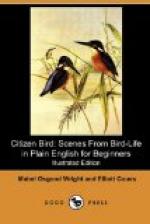“If she but gives one cluck of alarm, they vanish, under the leaves or twigs, and do not stir again until they hear her say the danger is over. And that patient watchful Mother Grouse has as many ways of leading an enemy away from her nest as any House Mother could devise if her children were in danger.
“This Grouse is a Ground Gleaner, a Seed Sower, and a Weed Warrior also in autumn. When snow covers all other food, he nips buds from low plants.
[Illustration: Ruffed Grouse.]
“Sometimes he burrows in deep snow for shelter from the cold, and then is liable to be caught by a sleet storm and frozen in his hiding-place. So you see his life is not altogether an easy one.
“The young Grouse stay with their parents until they are old enough to choose mates for themselves; but the flocks are never as large as the covey Bob White musters about him.
“The American Woodcock, the last of the trio, and the most wary of all, belongs to a family of shore birds who patter about the water’s edge; but he does not often go in wading, and prefers seclusion in the woods that border swamps. He is a worm and grub eater who, by the aid of his long straight bill, which has a sensitive tip like your finger, can feel his food when it is out of sight, and is able to probe the soft mud for things to eat that other birds cannot find. The strangest thing about his bill is, that the upper half of it can be bent at the end, almost as much as you can crook the last joint of your fingers. Such a bill is of the greatest assistance to him, as his eyes are set so far in the back of his head that he cannot see what he eats.”
“How queer!” said Nat; “what is the reason for that? I suppose there must be a reason!”
“This is it. By being placed far back in his head his eyes become like two watch-towers, from which he can scan the country behind as well as in front, and be on the alert for enemies. Woodcocks are very cautious birds, keeping well hidden by day and feeding only during the twilight hours or at night.
“They do not pass the winter in the colder parts of the country, and so escape the suffering that often overtakes Bob White and the Ruffed Grouse. They must be able to brave snowstorms, however, at the latter end of the cold season; for sometimes, when they begin to lay in early April, winter changes its mind and comes back to give them a snow blanket.”
“You said that they are dancing birds,” said Dodo. “When do they dance?”
“They dance in the sky in spring and summer!” cried Rap, unable to keep still any longer. “I saw a pair of them doing it this year, when I was out with the miller, looking for his colt that had strayed into the big woods beyond the pond. He said he knew there must be a Woodcock about, because he saw the little round holes in the mud, where they had been boring for earthworms, and that is the way he knows where to find them in the fall when he wants to go hunting.”




